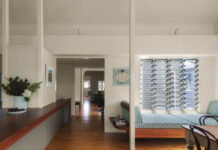[ad_1]
published about 3 hours ago
We independently select these products—if you buy from one of our links, we may earn a commission.
If you’re looking to expand your knowledge of design history, you’ve come to the right place. I polled a handful of designers on the most iconic furniture pieces and interior furnishings associated with each decade, from the 1920s to the 1990s, and have rounded up an expansive list of items you’ll want to add to your decorating repertoire. So get ready to go back in time and take some notes! Maybe on your next vintage shopping trip, you’ll even scoop up something iconic — or icon-inspired — on the cheap.
The design elements of the 1920s continue to shine 100 years later, maybe because many of the decade’s characteristic building materials, from steel to Bakelite plastic, were new at the time and truly revolutionized architecture and design, changing silhouettes and color palettes drastically. “This decade of modernism made a huge impact on the world of design, and it amazes me that this style still lives to this day,” designer Dawn Ianno says. “Some of the most iconic pieces that always stuck in my mind were from designers such as Le Corbusier, Marcel Breuer, and Ludwig Mies van der Rohe.”
Designer Laura Roberts pinpoints Le Corbusier’s LC2 Grand Comfort sofa as particularly noteworthy. “Known for its black leather cushions and tubular steel frame — a signature of the 1920s — the LC2 sofa and chair can still be seen everywhere from high-end homes to upscale hotels and waiting rooms,” she says. Frances Elkins’ loop chair was another 1920s gem, designer Josh Hildreth explains. “It’s an icon of design that was inspired by an English antique, and I love it for the fun and whimsy it brings to a room,” he says.
Sometimes simple is best, and that was the case in the ’30s with the Zig Zag chair from Dutch designer Gerrit Thomas Rietveld, which Roberts notes “was groundbreaking in its utter simplicity.” Though quite pricey today, particularly antique versions, the z-shaped, cantilevered solid wood chair was designed to be easily mass-produced at the time and plays on the viewer’s perception of balance and stability. “Made from four slices of elm and held together with dovetail joints and screws, the zig zag shape was so unique that it has become one of the most iconic and recognizable chairs ever designed,” Roberts says. Interestingly enough, this chair looks like it would be at home alongside all of the squiggles and wiggles in today’s wavy decor trend. What goes around certain comes around, at least when it comes to iconic interior pieces.
Designer Eugenia Triandos of Hibou Design & Co. greatly admires French designer Jean Royère’s Polar Bear Sofa. “Designed in 1947 and known for its curves, the Polar Bear Sofa is so unusual and beautiful at the same time,” she says. “We’re seeing the shape make a come back in modern pieces, where curves in sofas and upholstery are really starting resurface.”
Hildreth also appreciates this comfy-chic piece. “If there was ever a sofa that beckoned for a nap, this is the one,” he says of the Polar Bear, which originally was introduced in a plush, ultra soft woolen fabric. “Royère struck gold with this sofa that offers exquisite comfort without looking bulky or clumsy.”
Tracking down an authentic ’40s Polar Bear sofa is not only expensive (to the tune of half a million dollars at auction), but it’s also pretty difficult. If you like the look though, France & Son makes a repro version in three color ways — ivory bouclé (as shown above), buttercream, and red — that’s inspired by Royère’s iconic design but won’t set you back nearly as much.
Apparently, coziness was truly top of mind during this decade, which also birthed Eero Saarinen’s womb chair and ottoman for Knoll, another iconic pairing identified by designers. “The rounded lines of this piece make it so sculptural and so comfortable all at once,” designer Jean Liu shares. “It’s an all time favorite in our studio.”
One more iconic seat arrived on the design scene right at the end of the decade: the Wishbone Chair. Designed in 1949 and manufactured by Carl Hansen & Son a year later, the Wishbone Chair is still in production today, though its form references the simple beauty of medieval Ming Dynasty emperor’s chairs. “Inspired by Chinese Ming chairs, I love how Hans Wegner combined the more traditional Chinese lines with a modern Danish aesthetic,” says designer Rozit Arditi of Arditi Design. “Even though I really like the classic wood versions, the new colorful versions of the chair are absolute showstoppers.”
“Arguably one of the most iconic furniture designs of the 20th century is the Saarinen table (aka the Tulip table) by Eero Saarinen for Knoll,” designer Patrick Ediger explains. Ediger says that the Tulip collection, first introduced in 1957, “was at the forefront of ‘Space Age’ curvilinear design and feels timeless even by today’s standards — both sleek and cutting edge yet organic and sculptural.” In fact, Ediger is such a fan of the piece that he scooped up one of his own. “It’s one of a few mid-century treasures I have in my own home because it’s forever a classic,” he says.
If you can’t afford the real deal though, IKEA makes a pretty great inexpensive alternative, the DOCKSTA. Don’t feel limited to just your dining nook when it comes to finding a home for a Tulip-style dining table. “The simple yet sculptural lines of this table have lasted the test of time, from conference rooms and offices to kitchens and dining rooms, without losing its charm and classic beauty,” Arditi adds.
Pieces by Charles and Ray Eames also rose to popularity in the 1950s, including their molded plastic chairs and leather lounger and ottoman. “During the 1950s, there was a boom in furniture production, as more and more people were able to afford to buy homes in their quest for the ‘American Dream,’” Roberts explains. “Charles Eames led the way in designing furniture that was unique but easily mass-produced.” The Eames’ storage pieces also laid the groundwork in popularizing features that many of us today take for granted, too. “The series also offered a ton of flexibility, with components that could be interchanged to create consoles, book shelves, or desks,” says Roberts. “While modular components are a common feature in furniture today, it was a groundbreaking design at the time.”
“Chan” tables by Philip and Kelvin LaVerne, like the one Hildreth has in his own home as shown above, reigned supreme in the 1960s. “Inspired by ancient cultures, they combined pewter and bronze to create tables that provide richness, depth, and poetry to the lucky room wherever they land,” Hildreth says. “While modern in design, these iconic tables work everywhere and continue to appreciate in value.”
Also a staple of the 1960s — and more accessible in terms of its price point? The Verner Panton stacking side chair. “It continues to be knocked off by various manufacturers to this day, and Panton designed it intentionally to be easily mass-produced,” says Roberts. “There’s no other chair quite like it, and the unique sculptural shape makes it feel like a work of art.”
Last but not least, let’s not forget about the Platner table, which still feels on trend in today’s contemporary interiors, notes Liu. “The glass top and metal pedestal base make it so easy and functional to incorporate into so many aspects of our projects,” she says. “The fact it comes in coffee table, side table, and dining table versions makes it hard not to use over and over again.”
According to designer Michelle Berwick, the 1970s actually belong not to a piece of furniture but a key decorative furnishing: geometric wallpaper. “Who can picture a ’70s interior without some groovy wallpaper?” she says. “Earthy brown, rust, and mustard tones were key, as well as fun geometric patterns and bold florals.”
Of course, this look is still quite popular even well into the new millennium. “Design trends come and go, but this one is very prominent in our current decade,” notes Ianno. “There are so many great wallpaper choices; I love when clients tell me they want wallpaper in their home.”
Ladder-style bookshelves are all the rage today for those looking to store collections without the luxury of bespoke built-ins. These types of pieces owe their due to an iconic design that first debuted in the 1980s though: The Mac Gee bookshself by legendary designer Philippe Starck. “Graduating lengths of epoxy coated steel lean casually against a wall to create an elegant surface for display or storage,” says Roberts of these pieces. “While many shelves in this style are on the market today, Philippe Starck’s was the first.”
On the other end of the design spectrum, the Parish-Hadley collection for Baker furniture also rose to prominence in the 1980s. “This classic take on a Chippendale sofa (pictured above) oozes with playful sophistication with the exaggerated arm, curvy leg, and a backside to swoon over,” says Hildreth.
And just as many of us decorate with greenery today, the 1980s were also a plant-filled era, designer Marie Cloud of Indigo Pruitt Design Studio explains. “Houseplants really became a popular home aesthetic element — especially faux plants,” she notes. “I can still remember the thick dust that would accumulate on the leaves of my grandmother’s corner palms.”
If the home you lived in during the 1990s featured a white kitchen, you’re certainly not alone. According to Cloud, “People were requesting white cabinets to brighten their kitchens and give off a more softened and open appeal.” As Ianno notes, the look is still in today. “Everyone always asks if white cabinets are going out, but to be honest, they’ve been in since the ’90s and are still popular to this day.”
What will become an icon from the 2000s and 2010s? Only time will tell. These pieces certainly have set the design bar high though, and if you have a favorite throwback from this list — or something you think should have been on it but wasn’t — be sure to share it in the comments!
[ad_2]
www.apartmenttherapy.com










